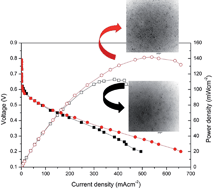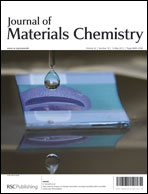A series of side-chain ratios of novel main-chain-type and side-chain-type sulfonated poly(ether ether ketone)s (MS-SPEEKs) were synthesised by reaction of the sulfonic acid groups of pristine SPEEKs with 2-aminoethanesulfonic acid to improve the nano-phase separated morphology of the material. 1H NMR and FT-IR spectroscopy was employed to determine the structure and composition of main-chain-type and side-chain-type sulfonated polymers. Flexible and tough membranes with reasonable thermal properties were obtained. The MS-SPEEKs showed good hydrolytic stability, and water uptake values that range from 17% to 25% were observed. Compared to Nafion® 117, the methanol permeability of the MS-SPEEKs was dramatically reduced to between 9.97 × 10−8 cm2 s−1 and 1.51 × 10−7 cm2 s−1. The proton conductivity increased with increasing temperature and reached 0.031–0.099 S cm−1. A maximum power density and open-circuit voltage of 142 mW cm−2 and 0.79 V, respectively, were obtained at 70 °C, which were significantly greater than the values generated with Nafion® 117. The introduction of pendent side-chain-type sulfonic acid groups with a side-chain ratio of 8% showed the best cell performance; thus, the lower water diffusivity, lower methanol permeability and higher cell performance indicated that MS-SPEEK was a promising candidate for DMFC applications.

You have access to this article
 Please wait while we load your content...
Something went wrong. Try again?
Please wait while we load your content...
Something went wrong. Try again?


 Please wait while we load your content...
Please wait while we load your content...